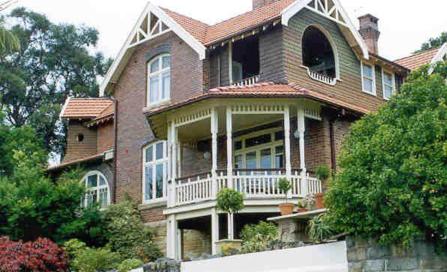|
‘Gundimaine’39 Shellcove Road, Neutral BayAlfred Spain designed ‘Gundimaine’ with Thomas Rowe in 1902-3.It was Spain's most significant local work and was completed just before his partnership with Thomas Cosh. The house was reputedly built for Mrs Elizabeth Brown Craig, wife of wealthy ship’s captain and merchant Robert Craig, on land leased from John Cooper who still owned much of Neutral Bay. However, it is Robert’s name that appears in Council records as the owner of the house at least until he commissioned BJ Waterhouse to design ‘Ailsa’ a short distance away. The Scotsman Craig had made his initial fortune by running guns to Confederate forces during the American Civil War in the 1860s. He settled in Sydney in 1877 and became one of the most successful traders in one of the British Empire's busiest ports. ‘Gundimaine’ showed the influence of English Revival styles and the strong cultural connection with Britain at a time when Australians were also exploring an independent identity as the colonies came together to form the Commonwealth of Australia in 1901. It is particularly interesting, however, that such an English style was chosen by a family with Scottish ancestry. The house fitted in with the dominant affluent architectural aesthetic of the area which had been established by Walter Liberty Vernon’s house ‘Penshurst’ and the houses on the Neutral Bay Land Company estate that he established in the 1880s. Almost manorial in its size and configuration, ‘Gundimaine’ was a two storey, 14 room house with a service wing and outbuildings that filled an ‘island’ block. The over-hanging oriel windows were a feature of English Revival styles. The multi-gabled roof is central to the picturesque variation of the building. It is ‘punctuated’ by tall striated brick chimneys, reminiscent of the English houses of Richard Norman Shaw – the doyen of the English Revivalism in Britain from the 1870s. 'Gundimaine' was divided into flatettes in the post-war period. However, when it was bought by Harry Napier Developments in 1980, it was protected by an Interim Heritage Order under the New South Wales Heritage Act 1977. Had the property been bought for redevelopment in the 1950s or 1960s it would have almost certainly been demolished and replaced by flats. Harry Napier Developments specialised in heritage redevelopments and the house and accompanying buildings were subsequently restored and converted into three apartments and one townhouse by the architects Gunhild Krogsdam and Peter Simpson. The conversion was widely regarded as an exemplary adaptation of an historic house.
|
|


![, Floor plan for Unit Two in the Napier Development prospectus for 'Gundimaine House', [1982]. Stanton Library](/auto/thumbnail/auto/sb-plugin-gopix/gundimaine/2_gundamaine-floor-plan_edited.jpg?maxwidth=182;maxheight=128;style=cropped;type=jpeg)

